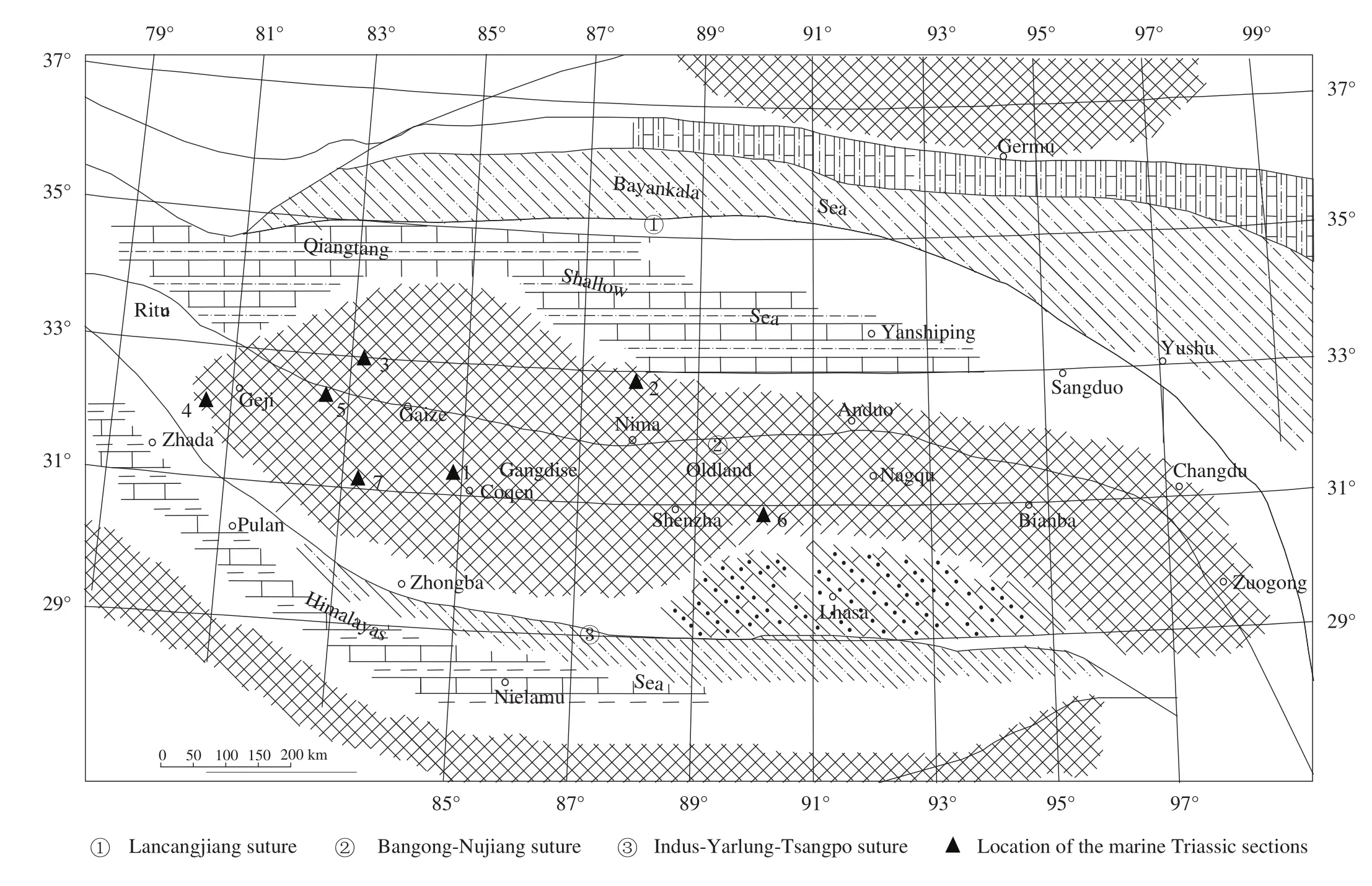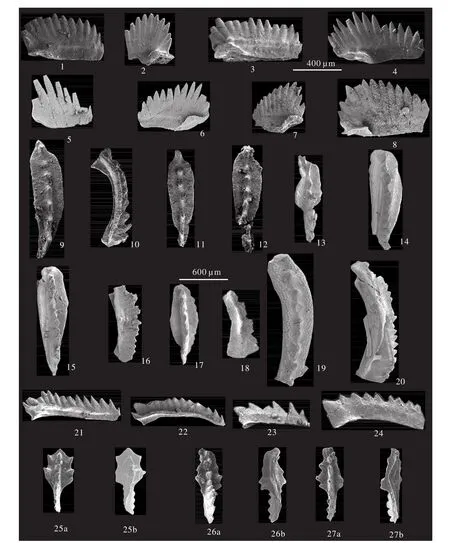Land submerged to carbonate platform by conodonts: paleoenvironment reconstruction of the western Gangdese in Tibet during Triassic
Zhn-sheng Ji, Jin-xin Yo, Gui-chun Wu,*, Qin Sun, Qiu-yun Shi, Ho Li, Ji-fu He,Sho-wen Zhng
a Chinese Academy of Geological Science, CAGS, Beijing 100037, China
b Institute of Geology, CAGS, Beijing 100037, China
1. Objectives
The western Gangdese in Tibet during Triassic was previously considered to be a part of the Gangdese Oldland(Zhao ZZ et al., 2001; Fig. 1). If the Gangdese Oldland did exist, it means no prospect of petroleum exploration of the Triassic strata in western Gangdese area. Fortunately, the recent biostratigraphic progresses don’t support the existence of the Gangdese Oldland. This paper aims to briefly introduce the new paleogeographic interpretation and the reason that the western Gangdese in the Triassic was marine instead of terrigenous on the basis of the recent conodont data.
2. Methods
The logic link of denying such a vast land as the Gangdese Oldland by discovering such tiny fossils as conodonts is based on the following geological principles. The first is the paleogeographic principle that the existence of an ancient land is interpreted by the absence of strata. The second is the sedimentologic principle that limestone or dolomite containing marine fossils were accumulated in an environment of carbonate platform or slope. The third is the stratigraphic principle that the existence of a certain-age strata is determined by the existence of its index fossils.
Conodonts, the index fossils for the marine strata from Middle Cambrian up to Late Triassic, played a critical role in the denying of the Gangdese Oldland. The conception of the Gangdese Oldland was established on the stratigraphic cognition that the Triassic strata did not deposit. If the above stratigraphic understanding is true, there is no chance to find Triassic conodonts. On the contrary, if Triassic conodonts were discovered, it suggests the existence of the Triassic marine strata. If the Triassic marine strata are found anywhere in the scope of the Gangdese Oldland, the conception of the Gangdese Oldland will be proved to be incorrect.Furthermore, the paleoenvironment of the related area of the Gangdese Oldland should be reinterpreted by the lithologic facies of the strata yielding Triassic conodonts.
3. Results
The conception of the Gangdese Oldland was first questioned by the discovery of the typical Late Triassic Norian conodont Epigondolella specimens in the so-called Middle Permian Xiala Formation at the Dibu Co section which is located in the middle west of the Gangdese Oldland by Ji ZS et al. in 2006. The above conodont data suggest the existence of the Late Triassic Norian carbonate sediments over there. The carbonate sediments suggest its environment probably was carbonate platform or slope, but never land as thought before. It is the first evidence to collapse the conception of the Gangdese Oldland. More conodont samples were collected and checked in the so-called Middle Permian Xiala Formation limestone nearby the Dibu Co section to verify its reliability. Inspiringly, not only Late Triassic conodonts are found repeatedly but also abundant Early and Middle Triassic conodonts were found (Fig. 2). Neogondolella carinata zone, Neospathodus triangularis - N. homeri zone, Chiosella timorensis zone, Paragondolella inclinata -P. polygnathiformis zone and Epigondolella zone, ranging from the Early Triassic to Late Triassic, could be recognized in ascending order.
术后第6天,转至我院治疗,患者神志模糊,GCS评分 12分(E4V3M5),伴发热(38.4℃),专科查体见右外耳道、乳突术腔干洁,留置纱条1条,无脓性分泌物,耳后伤口干洁。当天脑部CT提示右乳突呈术后改变;当天血常规示白细胞升高(10.9×109);脑脊液示白细胞记数(35×106/L),红细胞数(-),总蛋白(1.07g/L),葡萄糖(7.14mmol/L)。

Fig. 1.Sections producing Triassic conodonts in the“Gangdese land”(after Zhao ZZ et al., 2001 and references therein).

Fig. 2.Typical conodont specimens found at the Dibucuo section, Coqen County, Tibet. 1-Neospathodus homeri (Bender); 2-Neospathodus triangularis (Bender); 3-Chiosella timorensis (Nogami); 4-Neospathodus conservativus Muller; 5-Neospathodus dieneri Sweet; 6-Neospathodus cristagalli (Huckriede); 7, 8-Neospathodus waageni Sweet; 9–12-Neogondolella carinata (Clark); 13-Budurovignathus sp.; 14, 15-Neogondolella cf. szaboi (Kovacs); 16, 17-Paragondolella inclinata (Mosher); 18-Paragondolella polygnathiformis (Budurov and Stefanov);19-Gladigondolella tethydis (Huckriede); 20-transitional form from Paragondolella inclinata to Paragondolella polygnathiformis; 21,22-Neogondolella bulgarica (Budurov and Stefanov); 23-Paragondolella inclinata (Mosher); 24-Cratognathodus sp.; 25a, 25b-Epigondolella cf. englandi; 26a, 26b-Epigondolella sp.; 27a, 27b-the evolved Epigongdolella serruta Orchard. Scale bar is 400 μm for figures 1-8 and 600 μm for figures 9-30.
In addition, Early Triassic conodonts were discovered at the Mopanshan section and the Zishisang section in the Southern Qiangtang. The Southern Qiangtang has been considered to be the northward extending part of the Gangdese Oldland during Early and Middle Triassic. The Early Triassic conodonts were found in samples taken from the so-called Permian limestone by the geologists of the Guizou Institute of Geological Survey and Jilin Institute of Geological Survey respectively. These data indicate that the marine Triassic deposition spread widely in the so-called Gangdese Oldland.
我国外籍员工招聘主要集中在东部沿海的发达地区,其中北京招聘岗位为1 054个;广东有899个;上海为894个,江苏595个,浙江500个,排名前五的省市招聘数量约占全国总量的60%。其中广东省招聘外籍员工的需求主要聚集在深圳和广州这两个国际化都市,两市占全省招聘数量的70%。
主动脉瓣狭窄:可见明显加快的主动脉瓣向速度,患者收缩期最大开放幅度低于16毫米;主动脉瓣关闭不全:舒张期可见主动脉瓣下返流信号,关闭间隙不小于2毫米;瓣环及二尖瓣钙化:可见明显增强瓣环以及二尖瓣回声,厚度不低于3毫米;主动脉瓣钙化:主动脉瓣叶僵硬,增厚幅度不小于3毫米,活动明显受限[3]。
卓时Premier系列Precious月相功能腕表的镶钻表耳重现海瑞温斯顿纽约第五大道旗舰店的拱门造型,令人过目难忘,表圈与表耳共镶嵌57颗圆形明亮式切工钻石。 时、分指示及月相功能通过优质瑞士自动上链机械机心驱动,其动力储存长达68小时。腕表配备蓝色或棕色鳄鱼皮表带,搭配镶嵌17颗圆形明亮式切工钻石的白18K金或玫瑰18K金材质针扣。
Judging from one site of the Dibu Co area, the authors deduced that there was a vast carbonate platform or slope in the scope of the so-called Gangdese Oldland from Early Triassic to Late Triassic Norian. If this deduction is correct,more locations of the Triassic carbonate sediments could be found in the Gangdese Oldland elsewhere. Checking conodonts in the so-called Middle Permian Xiala formation elsewhere was inspired by the study of the Dibu Co section.
Then more conodont investigations were carried out in other locations to testify the existences of Triassic marine deposition. Inspiring and expectant results were obtained in the following works. Early Triassic conodonts were found at the Langjiu section of the Shiquanhe area in the westmost Gangdese Oldland by Ji ZS et al. in 2007. Late Triassic conodonts were found at the Yawa section by Ji ZS et al. in 2010. Early Triassic conodonts were found at the Wenbudangsang section in the northwest Gangdese Oldland by Wu GC et al. in 2014. Early Triassic conodonts were found both at the Namtso section by Wu GC et al. in 2017 and at the Renduo section by Wu GC et al. in 2018.
In a similar way, the Early and Middle Triassic conodonts indicate that the existence of the Lower and Middle Triassic carbonate sediments and furtherly means its environment in this area was probably carbonate platform or slope in the Early and Middle Triassic too.
4. Conclusions
The newly-discovered conodonts reveal the existence of Triassic carbonate in several outcrops in the western Gangdese region and the southern Qiangtang region. The conception of the Gangdese Oldland should be eliminated for the investigation of conodonts which are typical marine microfossils. These scattered outcrops nowadays suggest the existence of a vast and continuous carbonate platform or slope environment during the Triassic.
For a more detailed discussion and mentioned references in this paper, refer to the summary papers (Ji ZS et al., 2008,2018).
Acknowledgment
This study was supported by National Natural Science Foundation of China (41472030), Basic Research Project of Ministry of Science and Technology of China(2015FY310100), China Geological Survey (DD20160120-02, DD20160120-04 and DD20160126), and Central Publicinterest Scientific Institution Basal Research Fund (J1607).
- China Geology的其它文章
- International Union of Geodesy and Geophysics: 27th General Assembly Conference
- Introduction of the Beijing SHRIMP Center (National Science and Technology Infrastructure)
- Features of micro-fabric and the genetic study of Triassic deep polyhalite in the Guang'an area, central Sichuan Basin
- An overview of the resources and environment conditions and major geological problems in the Yangtze River economic zone, China
- Geological characteristics, metallogenic regularities and the exploration of graphite deposits in China
- Exploration and research progress on ion-adsorption type REE deposit in South China

